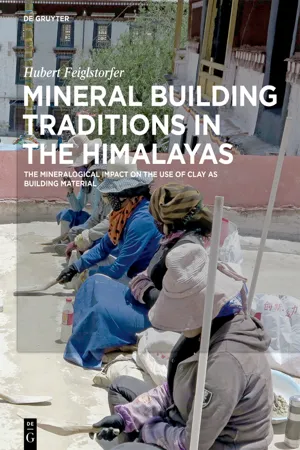
Mineral Building Traditions in the Himalayas
The Mineralogical Impact on the Use of Clay as Building Material
- 395 pages
- English
- ePUB (mobile friendly)
- Available on iOS & Android
Mineral Building Traditions in the Himalayas
The Mineralogical Impact on the Use of Clay as Building Material
About this book
Mineral building materials and regionally related methods of processing are an essential part of building culture throughout the Himalayas. Based on transregional knowledge transfer, raw materials have been able to find an ecologically and economically optimised destiny in particular local applications. For this study, samples were collected as raw material or originated from certain building components. Samples were analysed according to their material properties and architectural application. Traditional building techniques were examined and their correlation with traceable material qualities studied. Clay-specific properties such as colour, grain size distribution, grain shape, hardness, plasticity, organic additives, or bulk and clay mineral properties were used as comparative parameters.
This study gives fresh insight into the interaction between technical requirements, environmental resources and material implementation. It is the first scientific approach in studying the Himalayan earthen heritage in a wide scope and connecting material research and cultural heritage from various perspectives - in particular archaeology, architecture, research on materials and building techniques.
Frequently asked questions
- Essential is ideal for learners and professionals who enjoy exploring a wide range of subjects. Access the Essential Library with 800,000+ trusted titles and best-sellers across business, personal growth, and the humanities. Includes unlimited reading time and Standard Read Aloud voice.
- Complete: Perfect for advanced learners and researchers needing full, unrestricted access. Unlock 1.4M+ books across hundreds of subjects, including academic and specialized titles. The Complete Plan also includes advanced features like Premium Read Aloud and Research Assistant.
Please note we cannot support devices running on iOS 13 and Android 7 or earlier. Learn more about using the app.
Information
Table of contents
- Cover
- Title Page
- Copyright
- ACKNOWLEDGEMENTS
- Contents
- GENERAL REMARKS
- I. INTRODUCTION
- II. MINERAL TRADITIONS AT THE NYARMA MONASTERY IN LADAKH
- III. ARGA STONE ROOF CONSTRUCTION
- IV. MARKALAK CLAY
- V. SUMMARY AND FUTURE PERSPECTIVES
- VI. APPENDIX CHAPTER II
- VII. APPENDIX CHAPTER III
- VIII. APPENDIX CHAPTER IV
- IX. BIBLIOGRAPHY
- X. LIST OF ILLUSTRATIONS